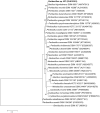Peribacillus castrilensis sp. nov.: A Plant-Growth-Promoting and Biocontrol Species Isolated From a River Otter in Castril, Granada, Southern Spain
- PMID: 35812926
- PMCID: PMC9262404
- DOI: 10.3389/fpls.2022.896728
Peribacillus castrilensis sp. nov.: A Plant-Growth-Promoting and Biocontrol Species Isolated From a River Otter in Castril, Granada, Southern Spain
Abstract
A strictly aerobic, chemoheterotrophic, endospore-forming, Gram-positive, rod-shaped bacterial strain N3T was isolated from the feces of a river otter in Castril (Granada, southern Spain). It is halotolerant, motile, and catalase-, oxidase-, ACC deaminase-, and C4- and C8-lipase-positive. It promotes tomato plant growth and can reduce virulence in Erwinia amylovora CECT 222T and Dickeya solani LMG 25993T through interference in their quorum-sensing systems, although other antagonistic mechanisms could also occur. A phylogenetic analysis of the 16S rRNA gene sequence as well as the phenotypic and phylogenomic analyses indicated that the strain N3T is a novel species of the genus Peribacillus, with the highest 16S rRNA sequence similar to that of Bacillus frigoritolerans DSM 8801T (99.93%) and Peribacillus simplex DSM 1321T (99.80%). Genomic digital DNA-DNA hybridization (dDDH) between the strain N3T and Bacillus frigoritolerans DSM 8801T and Peribacillus simplex was 12.8 and 69.1%, respectively, and the average nucleotide identity (ANIb) of strain N3T and Bacillus frigoritolerans DSM 8801T and Peribacillus simplex was 67.84 and 93.21%, respectively. The genomic G + C content was 40.3 mol%. Its main cellular fatty acids were anteiso-C15:0 and iso-C15:0. Using 16S rRNA phylogenetic and in silico phylogenomic analyses, together with the chemotaxonomic and phenotypic data, we demonstrated that the type strain N3T (=CECT 30509T = LMG 32505T) is a novel species of the genus Peribacillus and the name Peribacillus castrilensis sp. nov. is proposed.
Keywords: Peribacillus castrilensis; new species; phytopathogen; plant-growth promoting species; quorum quenching; river otter.
Copyright © 2022 Rodríguez, Reina, Sampedro, Llamas and Martínez-Checa.
Conflict of interest statement
The authors declare that the research was conducted in the absence of any commercial or financial relationships that could be construed as a potential conflict of interest.
Figures





References
-
- Alexander D. B., Zuberer D. A. (1991). Use of chrome azurol S reagents to evaluate siderophore production by rhizosphere bacteria. Biol. Fertil. Soils 12, 39–45. 10.1007/BF00369386 - DOI
LinkOut - more resources
Full Text Sources
Other Literature Sources
Molecular Biology Databases
Miscellaneous

